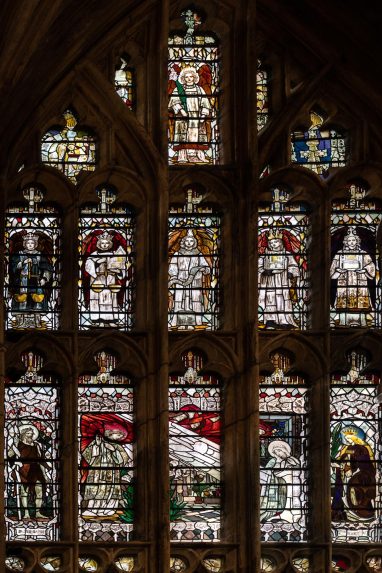Gloucester Cathedral, Gloucestershire
Address
Cathedral Church of the Holy and Indivisible Trinity, College Green, Gloucester GL1 2LXTheme
Overview
One of the great joys of English stained glass is the Great East Window of Gloucester Cathedral. Installed in the 1350s, it was at the time the largest window in the world and contains one of the largest areas of medieval stained glass in England. Take binoculars to enjoy some of the fine detail.
In the 19th century the cathedral commissioned windows from a number of the leading Victorian firms, of which, the Great West window by William Wailes, 1859, is particularly notable. There was a break with that tradition when Christopher Whall was commissioned to create windows for the restored Lady Chapel, as discussed below.
Other highlights include the stained glass in the chantry chapels of the Lady Chapel. In the south chantry chapel two memorial windows stand out. One to the former cathedral organist, Sir Alfred Brewer, is a beautiful set of angels by Veronica Whall, 1929, the second a memorial to Herbert Howells by Caroline Swash, 1992. Opposite in the north chantry chapel has a window by Tom Denny, 2013, in honour of Ivor Gurney, Gloucestershire’s most famous poet and a significant song composer. (Note: There is a further window by Tom Denny in the St Thomas chapel, 1992. More details can be seen on Art+Christianity’s Ecclesiart web pages, which raise awareness of significant works of modern and contemporary art since 1920 in UK churches and cathedrals.)
Highlight
Side windows of the Lady Chapel (except for the south-east window by Heaton, Butler & Bayne)Artist, maker and date
Designed by Christopher Whall and made at Lowndes & Drury, 1899-1910Reason for highlighting
The Lady Chapel had been closed for many years before a programme of repairs allowed its re-opening in 1897. Re-glazing was then required, but rather than continuing with the major Victorian firms used previously in the cathedral, the bold decision was taken to appoint a relatively unknown artist, Christopher Whall. The result was a triumphant success. Combining progressive stained glass on a really grand scale within such a large and significant medieval building made an important statement about the future of modern stained glass and elevated Whall into a major artist.
Artist/maker notes
Christopher Whitworth Whall (1849-1924) was one of the most prominent artists in the Arts & Crafts Movement, not only through his own work, but also through the influence he had on others as a teacher and writer. He taught at both the Central School of Arts and Crafts and the Royal College of Arts, and his 1905 book ‘Stained Glass Work’ is still widely regarded as the most inspirational practical book on the craft.
Sources:
Arts & Crafts Stained Glass by Peter Cormack (Yale University Press for The Paul Mellon Centre for Studies in British Art, 2015)
The Stained Glass Work of Christopher Whall by Peter Cormack (The Charles J Connick Stained Glass Foundation, 1999)
Lowndes & Drury was formed in 1897, by the artist Mary Lowndes (1857-1929) and the craftsman Alfred John Drury (1868-1940), with the aim of providing facilities for independent artists to design and make stained glass windows. They moved from cramped conditions in Chelsea to newly purpose-built premises, The Glass House, Fulham in 1906. The firm continued after the founders’ deaths, under Alfred Drury’s son, Victor, until he retired in the early 1970s. However, The Glass House premises continued in use under Carl Edwards and subsequently his daughter, Caroline Benyon, until she moved her studio to Hampton in1992.
Source: The Journal of Stained Glass, Vol. XLI, 2017


